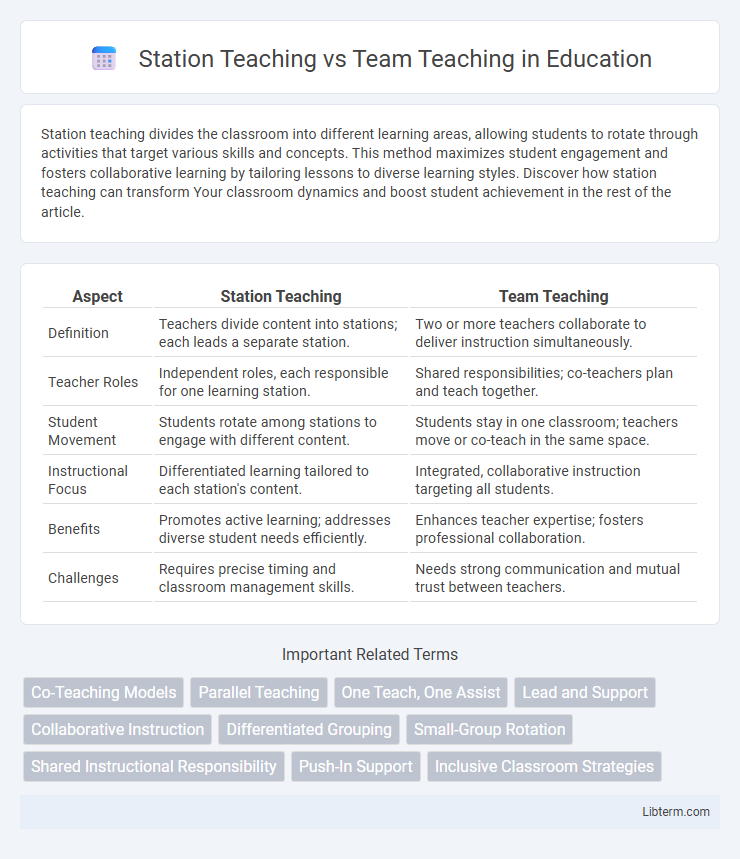Station teaching divides the classroom into different learning areas, allowing students to rotate through activities that target various skills and concepts. This method maximizes student engagement and fosters collaborative learning by tailoring lessons to diverse learning styles. Discover how station teaching can transform Your classroom dynamics and boost student achievement in the rest of the article.
Table of Comparison
| Aspect | Station Teaching | Team Teaching |
|---|---|---|
| Definition | Teachers divide content into stations; each leads a separate station. | Two or more teachers collaborate to deliver instruction simultaneously. |
| Teacher Roles | Independent roles, each responsible for one learning station. | Shared responsibilities; co-teachers plan and teach together. |
| Student Movement | Students rotate among stations to engage with different content. | Students stay in one classroom; teachers move or co-teach in the same space. |
| Instructional Focus | Differentiated learning tailored to each station's content. | Integrated, collaborative instruction targeting all students. |
| Benefits | Promotes active learning; addresses diverse student needs efficiently. | Enhances teacher expertise; fosters professional collaboration. |
| Challenges | Requires precise timing and classroom management skills. | Needs strong communication and mutual trust between teachers. |
Introduction to Co-Teaching Models
Station teaching divides students into small groups where each teacher is responsible for specific learning stations, promoting targeted instruction and efficient use of resources. Team teaching involves educators collaboratively delivering instruction to the entire class, enhancing interactive learning and providing diverse expertise. Both models support differentiated instruction and require effective collaboration, planning, and communication to maximize student engagement and achievement.
Defining Station Teaching
Station teaching is an instructional strategy where a classroom is divided into multiple learning centers, with students rotating through each station to engage in different tasks or subjects. This method allows teachers to provide focused, small-group instruction tailored to varying student needs or learning styles. Unlike team teaching, station teaching emphasizes student movement and autonomy across distinct activity zones rather than collaborative teacher delivery of a single lesson.
Understanding Team Teaching
Team teaching involves two or more instructors collaboratively planning, delivering, and assessing lessons within the same classroom, fostering dynamic interaction and leveraging diverse expertise. This model enhances student engagement by providing varied instructional styles and immediate peer support among teachers. Understanding team teaching requires recognizing its emphasis on shared responsibility and continuous communication to align teaching objectives and strategies effectively.
Key Differences Between Station and Team Teaching
Station teaching divides students into small groups rotating among different teachers or learning stations, allowing focused, differentiated instruction tailored to specific skills or subjects. Team teaching involves multiple educators collaboratively delivering the same lesson simultaneously to the entire class, promoting real-time interaction and unified instructional strategies. Key differences include the structure of student groupings, with station teaching emphasizing rotation and individualized attention, while team teaching centers on cooperative planning and synchronous delivery.
Benefits of Station Teaching
Station teaching enhances student engagement by dividing content into manageable segments, allowing learners to rotate through specialized stations tailored to diverse learning styles. This method increases individualized instruction time, enabling teachers to provide targeted support and immediate feedback. It fosters collaborative learning and boosts classroom efficiency by maximizing active participation and minimizing downtime.
Advantages of Team Teaching
Team teaching leverages the combined expertise of multiple educators, enhancing content delivery and providing diverse perspectives that cater to varying student learning styles. It fosters collaborative planning and real-time feedback, resulting in more dynamic and engaging instruction. This approach also supports differentiated instruction, enabling teachers to address individual student needs more effectively and improve overall academic outcomes.
Challenges Faced in Station Teaching
Station teaching often presents challenges such as coordinating lesson pacing among teachers to ensure smooth transitions between stations, which can disrupt student engagement. Managing classroom dynamics becomes complex as multiple activities occur simultaneously, requiring teachers to maintain effective communication and supervision. Resource allocation and ensuring consistent instructional quality across stations also demand careful planning and adaptability.
Obstacles in Team Teaching Implementation
Team teaching faces obstacles such as inconsistent communication among educators, leading to misaligned lesson objectives and teaching methods. Scheduling conflicts and unequal workload distribution often result in reduced collaboration and teacher burnout. Limited administrative support and lack of professional development opportunities further hinder effective team teaching implementation.
Effective Strategies for Choosing the Right Model
Station teaching divides students into small groups rotating through different teacher-led stations, enhancing personalized instruction and targeted skill practice. Team teaching involves two or more teachers sharing the responsibility of delivering the same lesson simultaneously, promoting collaboration and diverse instructional perspectives. Effective strategies for choosing the right model include assessing class size, subject complexity, teacher expertise, and student learning preferences to optimize engagement and learning outcomes.
Conclusion: Which Model Suits Your Classroom?
Station teaching offers a flexible approach ideal for classrooms with diverse learning needs and limited space, allowing small groups to rotate through focused instruction. Team teaching suits environments where collaboration between teachers enhances content delivery and student engagement through shared expertise. Choosing between these models depends on class size, teacher availability, and student learning styles to maximize instructional effectiveness.
Station Teaching Infographic

 libterm.com
libterm.com